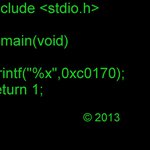mbed library sources
Dependents: Encrypted my_mbed lklk CyaSSL_DTLS_Cellular ... more
Superseded
This library was superseded by mbed-dev - https://os.mbed.com/users/mbed_official/code/mbed-dev/.
Development branch of the mbed library sources. This library is kept in synch with the latest changes from the mbed SDK and it is not guaranteed to work.
If you are looking for a stable and tested release, please import one of the official mbed library releases:
Import librarymbed
The official Mbed 2 C/C++ SDK provides the software platform and libraries to build your applications.
Diff: targets/cmsis/TARGET_STM/TARGET_STM32L0/stm32l0xx_hal_pwr.c
- Revision:
- 489:119543c9f674
- Parent:
- 382:ee426a420dbb
--- a/targets/cmsis/TARGET_STM/TARGET_STM32L0/stm32l0xx_hal_pwr.c Thu Mar 05 13:15:07 2015 +0000
+++ b/targets/cmsis/TARGET_STM/TARGET_STM32L0/stm32l0xx_hal_pwr.c Thu Mar 12 14:30:49 2015 +0000
@@ -2,8 +2,8 @@
******************************************************************************
* @file stm32l0xx_hal_pwr.c
* @author MCD Application Team
- * @version V1.1.0
- * @date 18-June-2014
+ * @version V1.2.0
+ * @date 06-February-2015
* @brief PWR HAL module driver.
*
* This file provides firmware functions to manage the following
@@ -11,11 +11,10 @@
* + Initialization/de-initialization functions
* + Peripheral Control functions
*
- @verbatim
******************************************************************************
* @attention
*
- * <h2><center>© COPYRIGHT(c) 2014 STMicroelectronics</center></h2>
+ * <h2><center>© COPYRIGHT(c) 2015 STMicroelectronics</center></h2>
*
* Redistribution and use in source and binary forms, with or without modification,
* are permitted provided that the following conditions are met:
@@ -45,43 +44,46 @@
/* Includes ------------------------------------------------------------------*/
#include "stm32l0xx_hal.h"
+#ifdef HAL_PWR_MODULE_ENABLED
/** @addtogroup STM32L0xx_HAL_Driver
* @{
*/
-/** @defgroup PWR
- * @brief PWR HAL module driver
+/** @addtogroup PWR
* @{
*/
-#ifdef HAL_PWR_MODULE_ENABLED
+/** @addtogroup PWR_Private_Defines
+ * @{
+ */
+
+/** @defgroup PWR_PVD_Mode_Mask PWR PVD Mode Mask
+ * @{
+ */
+#define PVD_MODE_IT ((uint32_t)0x00010000)
+#define PVD_MODE_EVT ((uint32_t)0x00020000)
+#define PVD_RISING_EDGE ((uint32_t)0x00000001)
+#define PVD_FALLING_EDGE ((uint32_t)0x00000002)
+/**
+ * @}
+ */
-/* Private typedef -----------------------------------------------------------*/
-/* Private define ------------------------------------------------------------*/
-/* Private macro -------------------------------------------------------------*/
-/* Private variables ---------------------------------------------------------*/
-/* Private function prototypes -----------------------------------------------*/
-/* Private functions ---------------------------------------------------------*/
+/**
+ * @}
+ */
+
-/** @defgroup PWR_Private_Functions
+/** @addtogroup PWR_Exported_Functions
* @{
*/
-/** @defgroup PWR_Group1 Initialization and De-initialization functions
- * @brief Initialization and Configuration functions
+/** @addtogroup PWR_Exported_Functions_Group1
+ * @brief Initialization and de-initialization functions
*
@verbatim
===============================================================================
##### Initialization and de-initialization functions #####
===============================================================================
- [..]
- After reset, the backup domain (RTC registers, RTC backup data
- registers) is protected against possible unwanted
- write accesses.
- To enable access to the RTC Domain and RTC registers, proceed as follows:
- (+) Enable the Power Controller (PWR) APB1 interface clock using the
- __PWR_CLK_ENABLE() macro.
- (+) Enable access to RTC domain using the HAL_PWR_EnableBkUpAccess() function.
@endverbatim
* @{
@@ -89,49 +91,20 @@
/**
* @brief Deinitializes the HAL PWR peripheral registers to their default reset values.
- * @param None
* @retval None
*/
void HAL_PWR_DeInit(void)
{
- __PWR_FORCE_RESET();
- __PWR_RELEASE_RESET();
-}
-
-/**
- * @brief Enables access to the backup domain (RTC registers, RTC
- * backup data registers ).
- * @note If the HSE divided by 2, 4, 8 or 16 is used as the RTC clock, the
- * Backup Domain Access should be kept enabled.
- * @param None
- * @retval None
- */
-void HAL_PWR_EnableBkUpAccess(void)
-{
- /* Enable access to RTC and backup registers */
- PWR->CR |= PWR_CR_DBP;
-}
-
-/**
- * @brief Disables access to the backup domain (RTC registers, RTC
- * backup data registers).
- * @note If the HSE divided by 2, 4, 8 or 16 is used as the RTC clock, the
- * Backup Domain Access should be kept enabled.
- * @param None
- * @retval None
- */
-void HAL_PWR_DisableBkUpAccess(void)
-{
- /* Disable access to RTC and backup registers */
- PWR->CR &= (uint32_t)~((uint32_t)PWR_CR_DBP);
+ __HAL_RCC_PWR_FORCE_RESET();
+ __HAL_RCC_PWR_RELEASE_RESET();
}
/**
* @}
*/
-/** @defgroup PWR_Group2 Peripheral Control functions
- * @brief Low Power modes configuration functions
+/** @addtogroup PWR_Exported_Functions_Group2
+ * @brief Low Power modes configuration functions
*
@verbatim
@@ -139,6 +112,17 @@
##### Peripheral Control functions #####
===============================================================================
+ *** Backup domain ***
+ =========================
+ [..]
+ After reset, the backup domain (RTC registers, RTC backup data
+ registers) is protected against possible unwanted
+ write accesses.
+ To enable access to the RTC Domain and RTC registers, proceed as follows:
+ (+) Enable the Power Controller (PWR) APB1 interface clock using the
+ __HAL_RCC_PWR_CLK_ENABLE() macro.
+ (+) Enable access to RTC domain using the HAL_PWR_EnableBkUpAccess() function.
+
*** PVD configuration ***
=========================
[..]
@@ -151,7 +135,7 @@
(+) A PVDO flag is available to indicate if VDD/VDDA is higher or lower
than the PVD threshold. This event is internally connected to the EXTI
line16 and can generate an interrupt if enabled. This is done through
- __HAL_PVD_EXTI_ENABLE_IT() macro.
+ __HAL_PWR_PVD_EXTI_ENABLE_IT() macro.
(+) The PVD is stopped in Standby mode.
*** WakeUp pin configuration ***
@@ -162,6 +146,8 @@
(+) There are two WakeUp pins:
WakeUp Pin 1 on PA.00.
WakeUp Pin 2 on PC.13.
+ WakeUp Pin 3 on PE.06 .
+
[..]
*** Main and Backup Regulators configuration ***
@@ -170,12 +156,12 @@
(+) The main internal regulator can be configured to have a tradeoff between
performance and power consumption when the device does not operate at
the maximum frequency. This is done through __HAL_PWR_VOLTAGESCALING_CONFIG()
- macro which configure VOS bit in PWR_CR register:
- (++) When this bit is set (Regulator voltage output Scale 1 mode selected)
+ macro which configures the two VOS bits in PWR_CR register:
+ (++) PWR_REGULATOR_VOLTAGE_SCALE1 (VOS bits = 01), the regulator voltage output Scale 1 mode selected and
the System frequency can go up to 32 MHz.
- (++) When this bit is reset (Regulator voltage output Scale 2 mode selected)
+ (++) PWR_REGULATOR_VOLTAGE_SCALE2 (VOS bits = 10), the regulator voltage output Scale 2 mode selected and
the System frequency can go up to 16 MHz.
- (++) When this bit is reset (Regulator voltage output Scale 3 mode selected)
+ (++) PWR_REGULATOR_VOLTAGE_SCALE3 (VOS bits = 11), the regulator voltage output Scale 3 mode selected and
the System frequency can go up to 4.2 MHz.
Refer to the datasheets for more details.
@@ -202,7 +188,7 @@
(+) Entry:
(++) VCORE in range2
- (++) Decrease the system frequency tonot exceed the frequency of MSI frequency range1.
+ (++) Decrease the system frequency not to exceed the frequency of MSI frequency range1.
(++) The regulator is forced in low power mode using the HAL_PWREx_EnableLowPowerRunMode()
function.
(+) Exit:
@@ -221,7 +207,8 @@
(+) Exit:
(++) Any peripheral interrupt acknowledged by the nested vectored interrupt
- controller (NVIC) can wake up the device from Sleep mode.
+ controller (NVIC) can wake up the device from Sleep mode. If the WFE instruction was used to enter sleep mode,
+ the MCU exits Sleep mode as soon as an event occurs.
*** Low power sleep mode ***
============================
@@ -256,7 +243,7 @@
In Stop mode, all I/O pins keep the same state as in Run mode.
(+) Entry:
- The Stop mode is entered using the HAL_PWR_EnterSTOPMode(PWR_MAINREGULATOR_ON, PWR_SLEEPENTRY_WFI )
+ The Stop mode is entered using the HAL_PWR_EnterSTOPMode
function with:
(++) Main regulator ON.
(++) Low Power regulator ON.
@@ -341,84 +328,102 @@
to be sensitive to to the selected edges (falling, rising or falling
and rising) (Interrupt or Event modes) using the EXTI_Init() function.
(+++) Configure the comparator to generate the event.
-
@endverbatim
* @{
*/
/**
- * @brief Configures the voltage threshold detected by the Power Voltage Detector(PVD).
- * @param sConfigPVD: pointer to an PWR_PVDTypeDef structure that contains the configuration
- * information for the PVD.
- * @note Refer to the electrical characteristics of your device datasheet for
+ * @brief Enables access to the backup domain (RTC registers, RTC
+ * backup data registers ).
+ * @note If the HSE divided by 2, 4, 8 or 16 is used as the RTC clock, the
+ * Backup Domain Access should be kept enabled.
+ * @retval None
+ */
+void HAL_PWR_EnableBkUpAccess(void)
+{
+ /* Enable access to RTC and backup registers */
+ SET_BIT(PWR->CR, PWR_CR_DBP);
+}
+
+/**
+ * @brief Disables access to the backup domain
+ * @note Applies to RTC registers, RTC backup data registers.
+ * @note If the HSE divided by 2, 4, 8 or 16 is used as the RTC clock, the
+ * Backup Domain Access should be kept enabled.
+ * @retval None
+ */
+void HAL_PWR_DisableBkUpAccess(void)
+{
+ /* Disable access to RTC and backup registers */
+ CLEAR_BIT(PWR->CR, PWR_CR_DBP);
+}
+
+/**
+ * @brief Configures the voltage threshold detected by the Power Voltage Detector(PVD).
+ * @param sConfigPVD: pointer to an PWR_PVDTypeDef structure that contains the configuration
+ * information for the PVD.
+ * @note Refer to the electrical characteristics of your device datasheet for
* more details about the voltage threshold corresponding to each
* detection level.
* @retval None
*/
-void HAL_PWR_PVDConfig(PWR_PVDTypeDef *sConfigPVD)
+void HAL_PWR_ConfigPVD(PWR_PVDTypeDef *sConfigPVD)
{
- uint32_t tmpreg = 0;
-
/* Check the parameters */
assert_param(IS_PWR_PVD_LEVEL(sConfigPVD->PVDLevel));
-
- tmpreg = PWR->CR;
-
- /* Clear PLS[7:5] bits */
- tmpreg &= ~ (uint32_t)PWR_CR_PLS;
+ assert_param(IS_PWR_PVD_MODE(sConfigPVD->Mode));
/* Set PLS[7:5] bits according to PVDLevel value */
- tmpreg |= sConfigPVD->PVDLevel;
-
- /* Store the new value */
- PWR->CR = tmpreg;
+ MODIFY_REG(PWR->CR, PWR_CR_PLS, sConfigPVD->PVDLevel);
+
+ /* Clear any previous config. Keep it clear if no event or IT mode is selected */
+ __HAL_PWR_PVD_EXTI_DISABLE_EVENT();
+ __HAL_PWR_PVD_EXTI_DISABLE_IT();
+ __HAL_PWR_PVD_EXTI_DISABLE_FALLING_EDGE();
+ __HAL_PWR_PVD_EXTI_DISABLE_RISING_EDGE();
- /* Configure the EXTI 16 interrupt */
- if((sConfigPVD->Mode == PWR_MODE_IT_RISING_FALLING) ||\
- (sConfigPVD->Mode == PWR_MODE_IT_FALLING) ||\
- (sConfigPVD->Mode == PWR_MODE_IT_RISING))
+ /* Configure interrupt mode */
+ if((sConfigPVD->Mode & PVD_MODE_IT) == PVD_MODE_IT)
{
- __HAL_PVD_EXTI_ENABLE_IT(PWR_EXTI_LINE_PVD);
+ __HAL_PWR_PVD_EXTI_ENABLE_IT();
}
- /* Clear the edge trigger for the EXTI Line 16 (PVD) */
- EXTI->RTSR &= ~EXTI_RTSR_TR16;
- EXTI->FTSR &= ~EXTI_FTSR_TR16;
-
- /* Configure the rising edge */
- if((sConfigPVD->Mode == PWR_MODE_IT_RISING_FALLING) ||\
- (sConfigPVD->Mode == PWR_MODE_IT_RISING))
+ /* Configure event mode */
+ if((sConfigPVD->Mode & PVD_MODE_EVT) == PVD_MODE_EVT)
{
- EXTI->RTSR |= PWR_EXTI_LINE_PVD;
+ __HAL_PWR_PVD_EXTI_ENABLE_EVENT();
}
- /* Configure the falling edge */
- if((sConfigPVD->Mode == PWR_MODE_IT_RISING_FALLING) ||\
- (sConfigPVD->Mode == PWR_MODE_IT_FALLING))
+
+ /* Configure the edge */
+ if((sConfigPVD->Mode & PVD_RISING_EDGE) == PVD_RISING_EDGE)
{
- EXTI->FTSR |= PWR_EXTI_LINE_PVD;
+ __HAL_PWR_PVD_EXTI_ENABLE_RISING_EDGE();
+ }
+
+ if((sConfigPVD->Mode & PVD_FALLING_EDGE) == PVD_FALLING_EDGE)
+ {
+ __HAL_PWR_PVD_EXTI_ENABLE_FALLING_EDGE();
}
}
/**
* @brief Enables the Power Voltage Detector(PVD).
- * @param None
* @retval None
*/
void HAL_PWR_EnablePVD(void)
{
/* Enable the power voltage detector */
- PWR->CR |= PWR_CR_PVDE;
+ SET_BIT(PWR->CR, PWR_CR_PVDE);
}
/**
* @brief Disables the Power Voltage Detector(PVD).
- * @param None
* @retval None
*/
void HAL_PWR_DisablePVD(void)
{
/* Disable the power voltage detector */
- PWR->CR &= (uint32_t)~((uint32_t)PWR_CR_PVDE);
+ CLEAR_BIT(PWR->CR, PWR_CR_PVDE);
}
/**
@@ -427,6 +432,7 @@
* This parameter can be one of the following values:
* @arg PWR_WAKEUP_PIN1
* @arg PWR_WAKEUP_PIN2
+ * @arg PWR_WAKEUP_PIN3 for stm32l07xxx and stm32l08xxx devices only.
* @retval None
*/
void HAL_PWR_EnableWakeUpPin(uint32_t WakeUpPinx)
@@ -434,7 +440,7 @@
/* Check the parameter */
assert_param(IS_PWR_WAKEUP_PIN(WakeUpPinx));
/* Enable the EWUPx pin */
- PWR->CSR |= WakeUpPinx;
+ SET_BIT(PWR->CSR, WakeUpPinx);
}
/**
@@ -443,6 +449,7 @@
* This parameter can be one of the following values:
* @arg PWR_WAKEUP_PIN1
* @arg PWR_WAKEUP_PIN2
+ * @arg PWR_WAKEUP_PIN3 for stm32l07xxx and stm32l08xxx devices only.
* @retval None
*/
void HAL_PWR_DisableWakeUpPin(uint32_t WakeUpPinx)
@@ -450,7 +457,7 @@
/* Check the parameter */
assert_param(IS_PWR_WAKEUP_PIN(WakeUpPinx));
/* Disable the EWUPx pin */
- PWR->CSR &= ~WakeUpPinx;
+ CLEAR_BIT(PWR->CSR, WakeUpPinx);
}
/**
@@ -475,19 +482,20 @@
assert_param(IS_PWR_REGULATOR(Regulator));
assert_param(IS_PWR_SLEEP_ENTRY(SLEEPEntry));
- /* Select the regulator state in Sleep mode ---------------------------------*/
+ /* Select the regulator state in Sleep mode ---------------------------------*/
tmpreg = PWR->CR;
+
/* Clear PDDS and LPDS bits */
- tmpreg &= (uint32_t)~(PWR_CR_PDDS | PWR_CR_LPSDSR);
+ CLEAR_BIT(tmpreg, (PWR_CR_PDDS | PWR_CR_LPSDSR));
/* Set LPSDSR bit according to PWR_Regulator value */
- tmpreg |= Regulator;
+ SET_BIT(tmpreg, Regulator);
/* Store the new value */
PWR->CR = tmpreg;
/* Clear SLEEPDEEP bit of Cortex System Control Register */
- SCB->SCR &= (uint32_t)~((uint32_t)SCB_SCR_SLEEPDEEP_Msk);
+ CLEAR_BIT(SCB->SCR, SCB_SCR_SLEEPDEEP_Msk);
/* Select SLEEP mode entry -------------------------------------------------*/
if(SLEEPEntry == PWR_SLEEPENTRY_WFI)
@@ -534,17 +542,18 @@
/* Select the regulator state in Stop mode ---------------------------------*/
tmpreg = PWR->CR;
+
/* Clear PDDS and LPDS bits */
- tmpreg &= (uint32_t)~(PWR_CR_PDDS | PWR_CR_LPSDSR);
+ CLEAR_BIT(tmpreg, (PWR_CR_PDDS | PWR_CR_LPSDSR));
/* Set LPSDSR bit according to PWR_Regulator value */
- tmpreg |= Regulator;
+ SET_BIT(tmpreg, Regulator);
/* Store the new value */
PWR->CR = tmpreg;
/* Set SLEEPDEEP bit of Cortex System Control Register */
- SCB->SCR |= SCB_SCR_SLEEPDEEP_Msk;
+ SET_BIT(SCB->SCR, SCB_SCR_SLEEPDEEP_Msk);
/* Select Stop mode entry --------------------------------------------------*/
if(STOPEntry == PWR_STOPENTRY_WFI)
@@ -561,7 +570,8 @@
}
/* Reset SLEEPDEEP bit of Cortex System Control Register */
- SCB->SCR &= (uint32_t)~((uint32_t)SCB_SCR_SLEEPDEEP_Msk);
+ CLEAR_BIT(SCB->SCR, SCB_SCR_SLEEPDEEP_Msk);
+
}
/**
@@ -571,18 +581,19 @@
* - RTC_AF1 pin (PC13) if configured for tamper, time-stamp, RTC
* Alarm out, or RTC clock calibration out.
* - RTC_AF2 pin (PC13) if configured for tamper.
- * - WKUP pin 1 (PA0) if enabled.
+ * - WKUP pin 1 (PA00) if enabled.
* - WKUP pin 2 (PC13) if enabled.
- * @param None
+ * - WKUP pin 3 (PE06) if enabled, for stm32l07xxx and stm32l08xxx devices only.
+ * - WKUP pin 3 (PA02) if enabled, for stm32l031xx devices only.
* @retval None
*/
void HAL_PWR_EnterSTANDBYMode(void)
{
/* Select Standby mode */
- PWR->CR |= PWR_CR_PDDS;
+ SET_BIT(PWR->CR, PWR_CR_PDDS);
/* Set SLEEPDEEP bit of Cortex System Control Register */
- SCB->SCR |= SCB_SCR_SLEEPDEEP_Msk;
+ SET_BIT(SCB->SCR, SCB_SCR_SLEEPDEEP_Msk);
/* This option is used to ensure that store operations are completed */
#if defined ( __CC_ARM)
@@ -593,27 +604,78 @@
}
/**
+ * @brief Indicates Sleep-On-Exit when returning from Handler mode to Thread mode.
+ * @note Set SLEEPONEXIT bit of SCR register. When this bit is set, the processor
+ * re-enters SLEEP mode when an interruption handling is over.
+ * Setting this bit is useful when the processor is expected to run only on
+ * interruptions handling.
+ * @retval None
+ */
+void HAL_PWR_EnableSleepOnExit(void)
+{
+ /* Set SLEEPONEXIT bit of Cortex System Control Register */
+ SET_BIT(SCB->SCR, ((uint32_t)SCB_SCR_SLEEPONEXIT_Msk));
+}
+
+
+/**
+ * @brief Disables Sleep-On-Exit feature when returning from Handler mode to Thread mode.
+ * @note Clears SLEEPONEXIT bit of SCR register. When this bit is set, the processor
+ * re-enters SLEEP mode when an interruption handling is over.
+ * @retval None
+ */
+void HAL_PWR_DisableSleepOnExit(void)
+{
+ /* Clear SLEEPONEXIT bit of Cortex System Control Register */
+ CLEAR_BIT(SCB->SCR, ((uint32_t)SCB_SCR_SLEEPONEXIT_Msk));
+}
+
+
+/**
+ * @brief Enables CORTEX M0+ SEVONPEND bit.
+ * @note Sets SEVONPEND bit of SCR register. When this bit is set, this causes
+ * WFE to wake up when an interrupt moves from inactive to pended.
+ * @retval None
+ */
+void HAL_PWR_EnableSEVOnPend(void)
+{
+ /* Set SEVONPEND bit of Cortex System Control Register */
+ SET_BIT(SCB->SCR, ((uint32_t)SCB_SCR_SEVONPEND_Msk));
+}
+
+
+/**
+ * @brief Disables CORTEX M0+ SEVONPEND bit.
+ * @note Clears SEVONPEND bit of SCR register. When this bit is set, this causes
+ * WFE to wake up when an interrupt moves from inactive to pended.
+ * @retval None
+ */
+void HAL_PWR_DisableSEVOnPend(void)
+{
+ /* Clear SEVONPEND bit of Cortex System Control Register */
+ CLEAR_BIT(SCB->SCR, ((uint32_t)SCB_SCR_SEVONPEND_Msk));
+}
+
+/**
* @brief This function handles the PWR PVD interrupt request.
* @note This API should be called under the PVD_IRQHandler().
- * @param None
* @retval None
*/
void HAL_PWR_PVD_IRQHandler(void)
{
/* Check PWR exti flag */
- if(__HAL_PVD_EXTI_GET_FLAG(PWR_EXTI_LINE_PVD) != RESET)
+ if(__HAL_PWR_PVD_EXTI_GET_FLAG() != RESET)
{
/* PWR PVD interrupt user callback */
HAL_PWR_PVDCallback();
/* Clear PWR Exti pending bit */
- __HAL_PVD_EXTI_CLEAR_FLAG(PWR_EXTI_LINE_PVD);
+ __HAL_PWR_PVD_EXTI_CLEAR_FLAG();
}
}
/**
* @brief PWR PVD interrupt callback
- * @param None
* @retval None
*/
__weak void HAL_PWR_PVDCallback(void)
@@ -641,3 +703,4 @@
*/
/************************ (C) COPYRIGHT STMicroelectronics *****END OF FILE****/
+
 mbed official
mbed official





